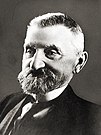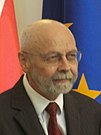Supreme Court of Poland
| Supreme Court of Poland | |
|---|---|
| Polish: Sąd Najwyższy | |
 | |
 | |
| Established | September 1, 1917 |
| Jurisdiction | Poland |
| Location | Warsaw |
| Composition method | Presidential nomination |
| Authorised by | Constitution of Poland |
| Number of positions | 120 (by statute) |
| Website | sn |
| First President of the Supreme Court | |
| Currently | Małgorzata Manowska |
| Since | May 25, 2020 |
 |
|---|


The Supreme Court (Polish: Sąd Najwyższy [ˈsɔnt najˈvɘʂ.ʂɘ] ⓘ) is the highest court in the Republic of Poland. It is located in the Krasiński Square, Warsaw.

The legal basis for the competence and activities of the Supreme Court is the Polish Constitution, the Act on the Supreme Court and the Presidential Decree on the organisation of the Supreme Court.[1]
History
[edit]The Supreme Court followed on from the Court of Cassation of the Principality of Warsaw. It began its work in 1917 during the First World War as the Royal Imperial Supreme Court (Polish: Królewsko-Cesarski Sąd Najwyższy).[2][3] Pomian-Srzednicki was appointed the first president of the court. After Poland gained full independence in 1918, the Supreme Court was reformed by decree of 8 February 1919 and many judges who were considered to be loyal to the emperor were dismissed.[2]
After the German invasion of Poland, the Supreme Court ceased its work. After the Second World War, the Supreme Court was reinstated with new judges who were now in line with the Soviet leadership. Its powers were reorganised by laws adopted in 1962 and 1984.[4][5] At the turn of 1989 the Supreme Court was dissolved and re-established, but for the most part with the old judges from the communist era.[6]
In 2002 a new legal basis for the organisation of the Supreme Court was created, replacing the old one of 1984.[7]
2017–2018 Constitutional Crisis
[edit]In 2017 the Polish government passed a law which would have forced all Supreme Court judges into mandatory retirement apart from those granted an extension by the Minister of Justice. The bill was passed in the Polish Sejm and the Senate however following mass protests against the bill it was ultimately vetoed by President Andrzej Duda on 24 June 2017. A revised bill reduced mandatory retirement age of judges from 70 to 65. The bill was later signed by President Duda and came into force in July 2018. The law effectively retires 40% of the Supreme Court bench including the First President of the Supreme Court, Malgorzata Gersdorf.
Polish opposition parties, the European Commission, the European Parliament, the Polish Supreme Court, and the National Council of the Judiciary have claimed the law is unconstitutional because it violates the principles of the independence of the judiciary. In August 2018 the Supreme Court sent questions to the European Court of Justice regarding the reforms. Under Union law the court can prevent the State law from coming into force if it undermines the treaties of the European Union regarding judicial independence.
On 17 December 2018, President Duda signed a law that will reinstate the judges who had been forced out of their jobs.[8]
On 8 April 2020 the EU Court of Justice ruled in a court case ("Commission v Poland") that the state of Poland "had failed to fulfil its obligations under EU law". As a result, the Court granted "the Commission’s application for interim measures" which will likely be realised with monetary fines.[9]
CJEU suspension of the Disciplinary Chamber
[edit]This section may be confusing or unclear to readers. (October 2021) |
On 12 October 2020, Adam Tomczyński, a Judge from the Disciplinary Chamber, waived the immunity of Beata Morawiec, judge of the District Court in Kraków. Moments after that the European Association of Judges expressed its unbreakable solidarity to Judge Beata Morawiec and to all independent Polish judges and once again stated that "The Disciplinary Chamber of the Polish Supreme Court is not a court and cannot continue to act as one" and urges the European Commission to take all necessary measures to urgently reestablish the EU legal order in Poland.[10][11]
Function
[edit]The Supreme Court supervises the adjudication in:
- General courts: these are district, circuit, and appeal courts. They adjudicate in the areas of civil, criminal, family and labour law.[12]
- Military courts: these are circuit and garrison courts. They deal with matters relating to crimes committed by soldiers in active service, civilian employees in military units, and prisoners of war.[12]
The Supreme Court is the court of last resort of appeal against judgements in the lower courts (except for administrative courts). It also passes resolutions to clarify specific legal provisions and resolve disputable questions in specific cases. These however are not (at least technically) legally binding.
Chambers
[edit]The Supreme Court has chambers for civil matters, criminal matters, labour and social security matters, exceptional supervision and public matters, and disciplinary matters.[13]
Appointment of judges
[edit]The President of Poland appoints Supreme Court judges for an indefinite period. This is done upon a motion of the National Council of the Judiciary. The President also selects the First President of the court from candidates presented by the General Assembly of the Supreme Court. The First President holds office for a six-year term. The First President may be dismissed by the Sejm upon a motion by the President if found convicted of a crime.[13]
In July 2018 a new law came into force which lowers the mandatory retirement age from 70 to 65.[14] The introduction of this law is contested and the constitutionality of the law is being assessed. Critics have argued the law is aimed at removing non-pliant judges and installing appointees desired by the current government, led by the Law and Justice party.
There are 120 posts for judges.[1]
List of First Presidents of the Supreme Court
[edit]| No | Name | Image | In office | Term length | Notes | |
|---|---|---|---|---|---|---|
| Republic of Poland | ||||||
| 1. | Stanisław Pomian-Srzednicki |  |
1 September 1917 – 28 February 1922 | 4 years, 180 days | [15] | |
| 2. | Franciszek Nowodworski |  |
1 March 1922 – 3 August 1924 | 2 years, 155 days | [16] | |
| 3. | Władysław Seyda |  |
22 September 1924 – 17 January 1929 | 4 years, 117 days | [17] | |
| 4. | Leon Supiński |  |
17 January 1929 – 1 September 1939 | 10 years, 227 days | [18] | |
| Polish People's Republic | ||||||
| 5. | Wacław Barcikowski |  |
26 January 1945 – 12 November 1956 | 11 years, 291 days | [19] | |
| 6. | Jan Wasilkowski | 12 December 1956 – 22 May 1967 | 10 years, 161 days | [20] | ||
| 7. | Zbigniew Resich | 3 May 1967 – 21 January 1972 | 4 years, 263 days | [21] | ||
| 8. | Jerzy Bafia | 21 January 1972 – 1 April 1976 | 4 years, 71 days | [22] | ||
| 9. | Włodzimierz Berutowicz | 1 April 1976 – 14 May 1987 | 11 years, 43 days | [23] | ||
| 10. | Adam Łopatka | 14 May 1987 – 30 June 1990 | 3 years, 47 days | [24] | ||
| Republic of Poland | ||||||
| No | Name | In office | President of Poland | Term length | Notes | |
| 11. | Adam Strzembosz |  |
1 July 1990 – 17 October 1998 | Wojciech Jaruzelski | 8 years, 108 days | [25] |
| 12. | Lech Gardocki |  |
17 October 1998 – 18 October 2010[26] | Aleksander Kwaśniewski | 12 years, 1 day | [27] |
| 13. | Stanisław Dąbrowski |  |
19 October 2010 – 9 January 2014 (died in office)[28] |
Bronisław Komorowski | 3 years, 82 days | [28] |
| – | Lech Paprzycki | 9 January 2014 – 30 April 2014 | 111 days | acting | ||
| 14. | Małgorzata Gersdorf[a] |  |
30 April 2014 – 30 April 2020[a] | 6 years, 0 days[a] | [29][30] | |
| – | Józef Iwulski | 4 July 2018 – 20 July 2018 | Andrzej Duda | 16 days | (disputed)[31] rejected appointment[a] | |
| – | Dariusz Zawistowski |  |
13 September – 31 December 2018 | 109 days | ||
| – | Kamil Zaradkiewicz | 1 May 2020 – 15 May 2020 | 14 days | (disputed)[31] resigned | ||
| – | Aleksander Stępkowski |  |
15 May 2020 – 25 May 2020 | 10 days | (disputed)[31] | |
| 15. | Małgorzata Manowska | 25 May 2020 – present[32] | 4 years, 219 days | (disputed)[31] | ||
Location
[edit]From 1917 to 1939, the Supreme Court met in the Krasiński Palace, which had already housed the Court of Cassation of the Principality of Warsaw before 1812.[33] From 1945 to 1950 the Supreme Court met in Łódź due to the destruction of Warsaw in the Second World War. From 1950 to 1999 it met in the building now used by the Warsaw Higher Regional Court. Since 1999, the Supreme Court has had its seat on Krasiński Square, diagonally opposite the Krasiński Palace, which is known for its 86 Latin inscriptions.[1][34]
Budget
[edit]The budget of the Supreme Court is set in the annual budget of Poland. In 2019, expenditure amounted to approximately PLN 160 million and revenue to PLN 0.26 million.[35]
See also
[edit]Literature
[edit]- L. Garlicki, Z. Resich, M. Rybicki, S. Włodyka: Sąd Najwyższy w PRL. 1983.
- M. Pietrzak: Sąd Najwyższy w II Rzeczypospolitej. Czasopismo Prawno-Historyczne, 1981.
- A. Rzepliński: Sądownictwo w PRL. Polonia Book, London 1990.
- S. Włodyka: Ustrój organów ochrony prawnej, Warsaw 1975.
Notes
[edit]- ^ a b c d Małgorzata Gersdorf and 26 of the 72 judges were forced out by mandatory retirement (set at 65 years old) starting on 4 July 2018. Józef Iwulski and Dariusz Zawistowski both insisted that Gersdorf remain in office, while the issue was brought before the European Court of Justice. Finally a Law reinstating the judges was signed on 17 December 2018, and Gersdorf fulfilled the remainder of her 6-year-term.
References
[edit]- ^ a b c "Rozporządzenie Prezydenta Rzeczypospolitej Polskiej z dnia 29 marca 2018 r. - Regulamin Sądu Najwyższego". isap.sejm.gov.pl. Retrieved 2020-11-04.
- ^ a b "Sąd Najwyższy - Historia". sadnajwyzszy (in Polish). Retrieved 2020-11-04.
- ^ Stępień-Załucka, Beata. (2016). Sprawowanie wymiaru sprawiedliwości przez Sąd Najwyższy w Polsce. Wydawnictwo C.H. Beck. Warszawa: Wydawnictwo C.H. Beck. ISBN 978-83-255-8067-4. OCLC 939906949.
- ^ "Ustawa z dnia 15 lutego 1962 r. o Sądzie Najwyższym". isap.sejm.gov.pl. Retrieved 2020-11-04.
- ^ "Ustawa z dnia 20 września 1984 r. o Sądzie Najwyższym". isap.sejm.gov.pl. Retrieved 2020-11-04.
- ^ "Ustawa z dnia 20 grudnia 1989 r. o zmianie ustaw - Prawo o ustroju sądów powszechnych, o Sądzie Najwyższym, o Naczelnym Sądzie Administracyjnym, o Trybunale Konstytucyjnym, o ustroju sądów wojskowych i Prawo o notariacie". isap.sejm.gov.pl. Retrieved 2020-11-04.
- ^ "Ustawa z dnia 23 listopada 2002 r. o Sądzie Najwyższym". isap.sejm.gov.pl. Retrieved 2020-11-04.
- ^ Joanna Berendt; Marc Santora (December 17, 2018). "Poland Reverses Supreme Court Purge, Retreating From Conflict With E.U." The New York Times. Retrieved December 18, 2018.
- ^ Court of Justice of the European Union (8 April 2020). "Commission v Poland (Press Release)" (PDF). curia.europa.eu.
- ^ "Izba Dyscyplinarna uchyliła immunitet sędzi Beacie Morawiec. Decyzja jest nieprawomocna". tvn24.pl. 12 October 2020. Archived from the original on 12 October 2020.
- ^ "Statement of the EAJ on Judge Beata Morawiec (Poland)". iaj-uim.org. 12 October 2020. Archived (PDF) from the original on 12 October 2020.
- ^ a b Kluwer, Wolters. "Sąd Najwyższy - Art. 183. - Konstytucja Rzeczypospolitej Polskiej". OpenLEX (in Polish). Retrieved 2020-11-04.
- ^ a b "Obwieszczenie Marszałka Sejmu Rzeczypospolitej Polskiej z dnia 4 kwietnia 2019 r. w sprawie ogłoszenia jednolitego tekstu ustawy o Sądzie Najwyższym". isap.sejm.gov.pl. Retrieved 2020-11-04.
- ^ "Druk nr 2003". www.sejm.gov.pl. Retrieved 2020-11-04.
- ^ PAD, Polska Akademia Dostępności-. "Stanisław Pomian-Srzednicki – Pierwszy Prezes Sądu Najwyższego - Archiwum Państwowe w Piotrkowie Trybunalskim". www.piotrkow-tryb.ap.gov.pl (in Polish). Retrieved 2020-11-04.
- ^ "Franciszek Nowodworski h. Nałęcz (II)". Sejm-Wielki.pl. Retrieved 2020-11-04.
- ^ "Seyda Władysław - Encyklopedia PWN - źródło wiarygodnej i rzetelnej wiedzy". encyklopedia.pwn.pl (in Polish). Retrieved 2020-11-04.
- ^ "Leon Supiński (1874–1950) - Leksykon - Teatr NN". teatrnn.pl (in Polish). Retrieved 2020-11-04.
- ^ "Barcikowski Wacław - Encyklopedia PWN - źródło wiarygodnej i rzetelnej wiedzy". encyklopedia.pwn.pl (in Polish). Retrieved 2020-11-04.
- ^ "Wasilkowski Jan - Encyklopedia PWN - źródło wiarygodnej i rzetelnej wiedzy". encyklopedia.pwn.pl (in Polish). Retrieved 2020-11-04.
- ^ "Resich Zbigniew - Encyklopedia PWN - źródło wiarygodnej i rzetelnej wiedzy". encyklopedia.pwn.pl (in Polish). Retrieved 2020-11-04.
- ^ "Gmach SN bez portretów komunistycznych sędziów. Decyzja prezesa Zaradkiewicza". www.tvp.info (in Polish). Retrieved 2020-11-04.
- ^ "Lustracja byłego ministra sprawiedliwości - Archiwum Rzeczpospolitej". archiwum.rp.pl. Retrieved 2020-11-04.
- ^ "Prof. Adam Łopatka nie żyje - Archiwum Rzeczpospolitej". archiwum.rp.pl. Retrieved 2020-11-04.
- ^ "Adam Strzembosz, Autor w serwisie Archiwum Osiatyńskiego". Archiwum Osiatyńskiego (in Polish). Retrieved 2020-11-04.
- ^ First term of office from 17 October 1998 to 17 October 2004, second term from 18 October 2004 to 18 October 2010.
- ^ Pierwsza kadencja w okresie 17 X 1998 – 17 X 2004, druga kadencja od 18 X 2004 do 18 X 2010.
- ^ a b "Sąd Najwyższy - Pro memoria - SDąbrowskiWsp". www.sn.pl. Retrieved 2020-11-04.
- ^ "Pierwszy Prezes Sądu Najwyższego – prof. dr hab. Małgorzata Gersdorf". sn.pl. Retrieved 2018-07-21.
- ^ "Małgorzata Gersdorf I Prezesem Sądu Najwyższego". Oficjalna strona Prezydenta Rzeczypospolitej Polskiej. 2014-04-30. Retrieved 2016-05-02.
- ^ a b c d "Sędzia SN Włodzimierz Wróbel: Mamy do czynienia z sytuacją wielkiego alarmu w systemie prawa". 27 May 2020. Archived from the original on 28 May 2020.
- ^ "Oficjalna strona Prezydenta Rzeczypospolitej Polskiej / Aktualności / Nominacje / Małgorzata Manowska powołana na stanowisko I Prezesa Sądu Najwyższego". www.prezydent.pl. Retrieved 2020-05-26.
- ^ "Sąd Najwyższy - Siedziba". sadnajwyzszy (in Polish). Retrieved 2020-11-04.
- ^ "Warszawa, gmach Sądu Najwyższego i pomnik powstania warszawskiego - Encyklopedia PWN - źródło wiarygodnej i rzetelnej wiedzy". encyklopedia.pwn.pl (in Polish). Retrieved 2020-11-04.
- ^ "Ustawa budżetowa na rok 2019 z dnia 16 stycznia 2019 r." (PDF). Dz. U. poz. 198. isap.sejm.gov.pl. 1 February 2019. pp. 10, 37. Retrieved 2019-12-30.
